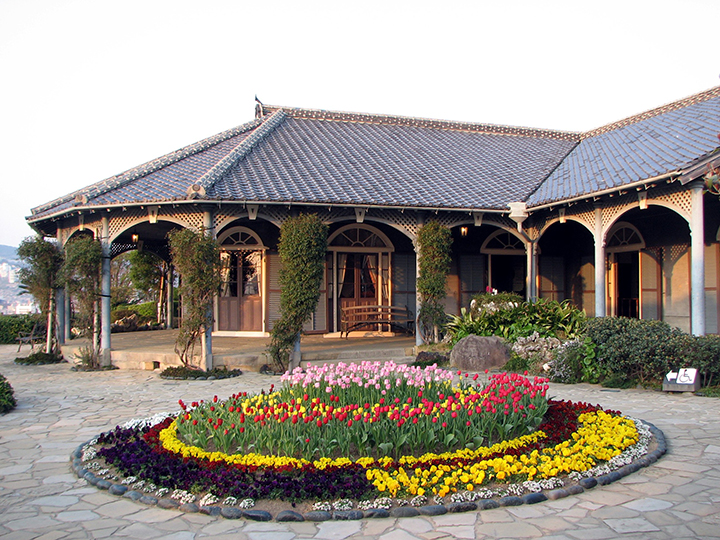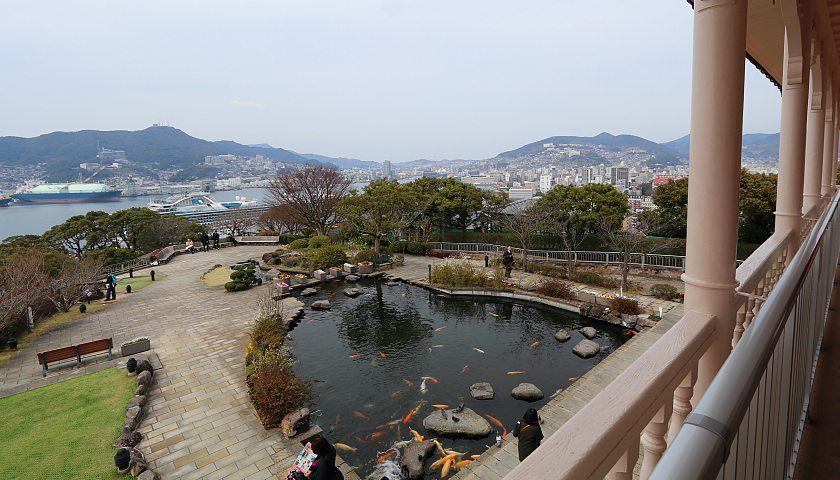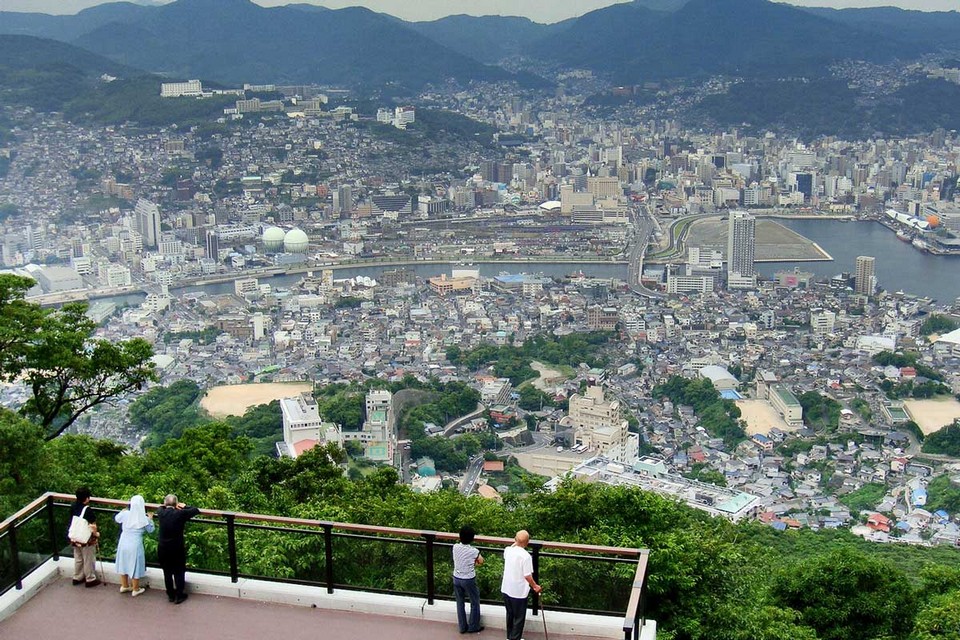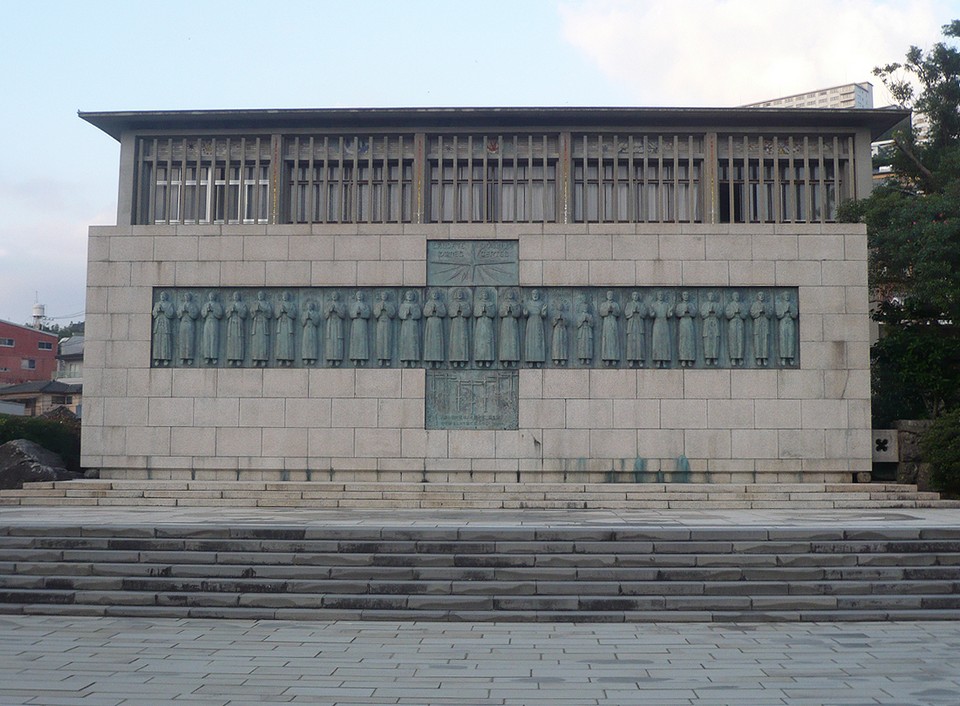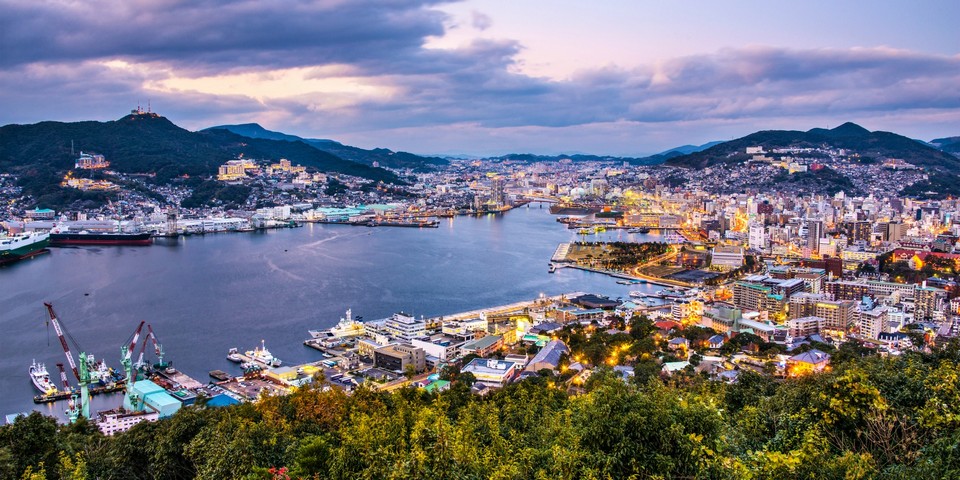Located in the Southwestern of Japan, Nagasaki is a picturesque port city with a mountain range on the horizon in background and an interesting mix of architectural styles despite its tragic history. While these pages of history can be found in touching museums and monuments, today’s Nagasaki is a lively coastal city with stunning views, striking with its long trading tradition (today is represented by giant ships), the natural beauty and fusion of Chinese, Japanese and European cuisines. In the city there are also 8 world heritage sites.
- 7 days in Japan itinerary: Suggested 1 week in Japan itinerary for what to do in Japan for 7 days
- The ULTIMATE Uji travel guide: Top attractions, best things to do in Uji Kyoto, Tips & MORE
- Kyoto itinerary 5 days: How to spend 5 days in kyoto perfectly?
- 19+ best sightseeing spots & most beautiful places to see in Japan: Mountains – Forests – Seas – Cities
- The ULTIMATE Gifu travel guide: Top attractions, best places to visit, stay & MORE


So, what to do and how to plan a budget perfect trip to Nagasaki for the first-time? Let’s check out our Nagasaki travel blog with the fullest Nagasaki travel guide (Nagasaki guide, Nagasaki tourist guide) from how to get, best time to come, where to stay, best places to visit and top things to do to find out the answer!


Nagasaki is the capital and largest city of Nagasaki Prefecture located on the northwest coast of the island of Kyushu, one of the four main islands of Japan. In Japanese history, it was one of the few cities in Japan that were allowed to trade with the outside world during the Middle Ages and was considered as a gateway to foreign trade. Therefore, when you come to Nagasaki you will notice this through the architecture here from European style houses, churches, gardens …

Within Nagasaki Prefecture and outside the city you will find amazing national parks which made up of numerous islands, lush seaside resorts, hot springs (onsen), spa treatments and rich flora. You’ll also find great restaurants, good shopping places, and most surprisingly a Dutch-style village which is famous for its colorful flower carpets.

Nagasaki travel guide: Overview Nagasaki

Nagasaki was Japan’s original gateway to trading with the West, and this influence is still evident in districts with dignified European-style houses and large numbers of Catholics. Clear connections with China and Korea in history that have continued to influence to the modernity of Nagasaki today, although the prefecture has had graves and remnants of these connections since the 3rd century B.C. The unspoiled beaches and island rest areas surrounded by clear blue waters attract swimmers, divers and kayakers, and Tsushima Island is also eco-friendly destination that attracts tourists who love nature with rich flora and fauna.

Nagasaki is one of the busiest ports in the country of cherry blossoms and is the gateway to introduce Western culture of Japan in the sixteenth century. But it is also a place associated with the horror of the century: At 11:2 a.m. on August 9, 1945, after three days of dropping the first atomic bomb in Hiroshima, the United States continued to persecute the Samurai Spirit, the courage of Japanese people with a second atomic bomb in Nagasaki, which was claimed 73,884 lives and injured 74,909 people, burned nearly 20,000 houses, and caused of over 120,000 people became homeless; not to mention millions of others affected by the radiation; suffering heavy physical and psychological losses for the rest of their life.

Nagasaki travel blog: When to visit?
If you are planning a trip, it is best to visit Nagasaki from April to May, and from September to November. The June and July weather can be quite wet. Nagasaki is also a city with many food or flower festivals. There are also beer festivals, oyster festivals, lantern festivals and tulip festivals – and that’s just the beginning. You will certainly be intrigued by the unique taste of Nagasaki.

Nagasaki Kunchi Festival
Nagasaki’s biggest festival of the year is held for 3 days from October 7-9 every year. Okunchi Festival is where districts in the city perform dances and parades to honor the gods or recreate the lives of local people.
Nagasaki travel guide: How to get?
If you are traveling by air, the nearby Nagasaki Airport or Fukuoka Airport are the best options for you. You can book a bus ticket from one of these airports that will take you directly to Nagasaki City. Alternatively, you can take a bullet train straight from Tokyo – or the major cities in between – to get to Hakata Station in Fukuoka. From here, you have two options: Take the bus or take the JR Kamome Limited Express Train to get to Nagasaki Station.

Private Fukuoka Airport Transfers (FUK) for Fukuoka
Airport information
- Nagasaki Airport (NGS)
- Distance to Nagasaki City: 18km
- Bus: Nagasaki Airport is actually located on an island in Omura city. The buses take longer than expected due to the winding mountain road. So you maybe spend 45 to 67 minutes riding to get to downtown Nagasaki by bus depending on one of the three bus routes you will choose. Fares are around ¥900 yen/one-way.
- Taxi: Taxi is a much faster means of getting to central Nagasaki, it takes about 35 minutes via the expressway. Fares around ¥9,560.

Nagasaki guide: Getting around the city
Bus, tram and taxi are popular means of transportation to getting around Nagasaki. You also can rent a bike, but remember that this is a city with many high hills so you should not rely on bicycles completely if you’re not physically fit.
Bus
Bus routes cover both the central and suburban areas. You can either buy a day ticket (Day Pass) or a single trip ticket – just get the ticket when you get on the bus, then put it in the ticket box near the driver when you get off and you will be charged for the distance you traveled.

Tram (Street car)
Street car is probably your best choice. Fares are the same class for all routes (only recommended to change the tickets if you want to change routes) or you can purchase daily tickets. There are four lines with different color codes and the map shows the routes very clearly.

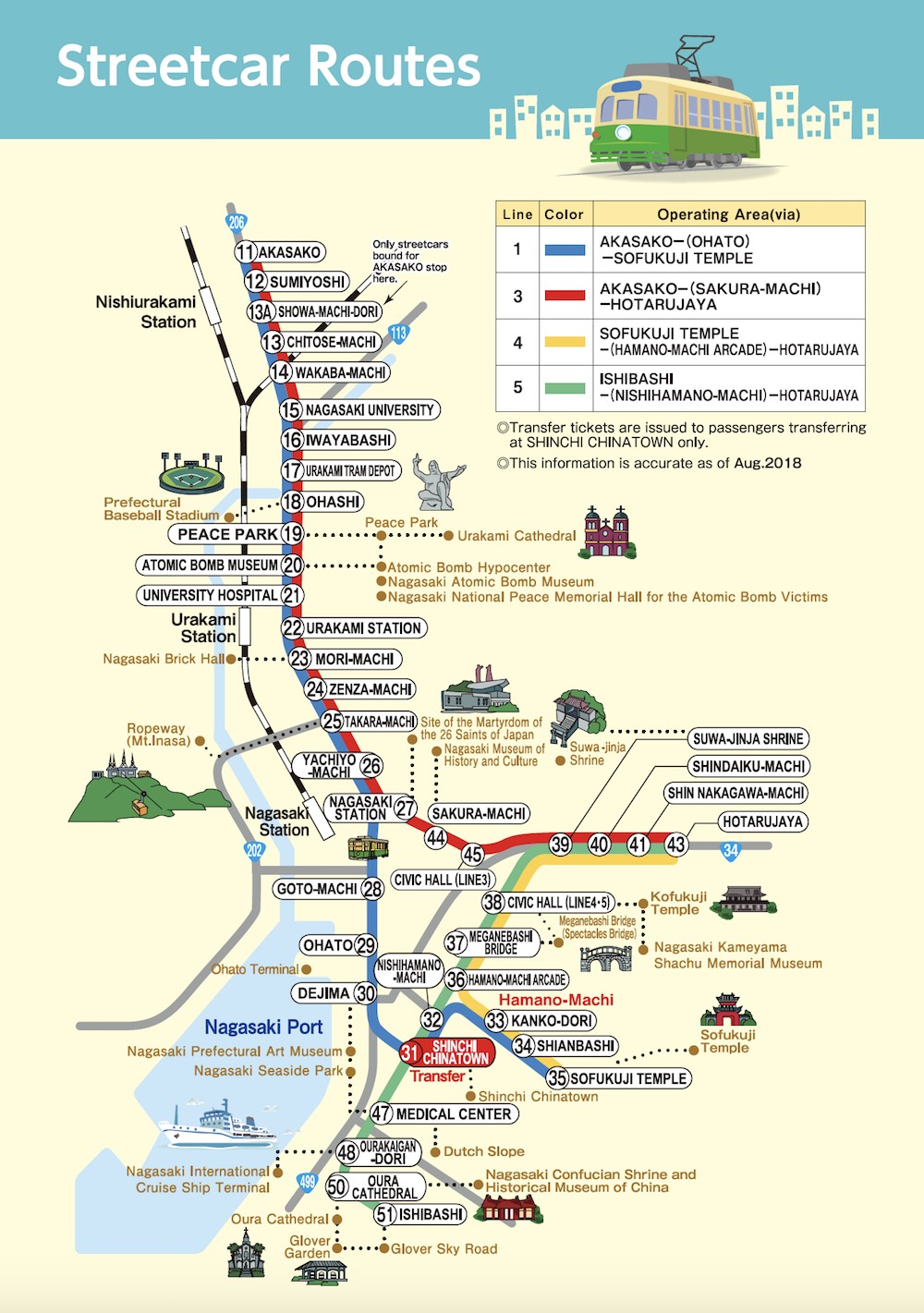
Taxi
You can rent a taxi on the street or at the taxi station. Most taxis only accept cash.
Nagasaki travel guide: Where to go and what to do
Nagasaki Peace Park
The peace park was built in 1955 to commemorate the victims who died in the atomic bomb attack on August 9, 1945. The park is divided into different zones with different meanings.
At the “Zone of Prayers” is the park’s famous 9.7 meter high peace memorial statue with the Hypocenter Cenotaph. This is a famous sculpture by the sculptor Seibou Kitamura called the Peace Statue.


Another area of the park that is interested in by visitors is the “Fountain of Peace”. It was built in August 1969, the fountain is a prayer for the resting of the victims. Bringing the image of dove wings symbolizing peace with 18 meters in diameter and 6 meters high.
Like the Hiroshima Peace Memorial, there is also Sadako’s Paper Cranes Monument at Nagasaki Peace Park to remind the Japanese children’s dream of living in peace during the years when the country sank during the war.

In the park there is also a place called “Zone of Study” which saving documents about the atomic bombing in Nagasaki. It re-enacts the city before and after the bombing including tools devastated to see the devastation of war that Japan suffered. This zone includes National Peace Memorial Hall, Nagasaki Atomic Bomb Museum Memory of Schoolchildren and Teachers killed by the “Fat Man” bomb.

There is also a sports ground, a square where people gather, participate in sports activities …
Address: 9 Matsuyamamachi, Nagasaki, 852-8118, Japan
Opened: April 1, 1955
Hours: Open 24 hours
Huis Ten Bosch Theme Park
As an theme park with the image of the beautiful Netherlands. It was named after a Dutch Royal family once resides here. One of the Nagasaki tourist destinations has a spacious space filled with an European atmosphere and style with picturesque canals up to 6km long, iconic windmills, beautiful gardens and unique architecture. Huis Ten Bosch gives visitors the feeling of living in the heart of ancient and poetic European cities, interesting stories about the way of Europeans entering Japan in the 16th century. It is also the venue for the world’s largest Light Festival and has a completely robotized hotel. Even more miraculously, there is also a forest of owls and a magical house with a chocolate theme. Have you been there yet?
Nagasaki Huis Ten Bosch Ticket
Address: 1-1 Huis Ten Bosch Machi, Sasebo, Nagasaki 859-3292, Japan
Area: 152 ha
Hours: 10AM–10PM
Oura Church
Oura Church is the most concrete symbol showing the cultural and religious interference in the Nagasaki period as one of the gateways of Japan to communicating and tradingn with the outside world. Built in 1864 with European architecture, this is the oldest Catholic church in Japan that still exists today.

At the main entrance is a statue of Maria “Nihon noseibozou” donated by the French to commemorate the finding of the Christian believers.
Although it is a Catholic church, it brings a calm and peaceful atmosphere for anyone who not related to religion can come to visit. This place is crowded with tourists and is one of the famous tourist destinations of Nagasaki city. If you want to avoid the crowded times, you should come early or come a little before closing time.

Address: 5-3 Minamiyamatemachi, Nagasaki, 850-0931, Japan
Opened: 1864
Hours: 8:30AM–5PM
Architects: Bernard Petitjean, Louis Furet
Architectural styles: Gothic architecture, Gothic Revival architecture
Glover Garden
Glover Garden bearing bold Western style and is a park with its central is three houses of three foreign businessmen who came to Japan at the end of the Shogunate period (Tokugawa shogunate, Edo period), namely Thomas Blake Glover, Frederick Ringer, and William John Orth. The houses have names corresponding to their previous owners: “Old Glover House”, “Old Ringer House”, “Old Orth House”.
In Glover garden has a stone paved area, on the wall with a water spray system … is a western-style landscape. In the paved area there is a heart-shaped rock. It is thought that if you touch this stone heart, your love will smoothly, so this is also considered a wonderful place for love.

Besides, due to it is located on a slope, you can see the surrounding landscape from within the garden. From mid-July to early October the park is open all night because this is when the houses in the Glover Garden will light up.

Address: 8-1 Minamiyamatemachi, Nagasaki, 850-0931, Japan
Hours: 8AM–6PM
Mount Inasa
With a height of 333m and is one of the 3 most beautiful night views mountains in Japan after Mount Kakodate in Hakodate and Mount Rokko in Kobe. On Inasa Mountain, there is an observation deck and a terrace so that any visitor who comes to can observe the entire view of Nagasaki port below.
To get to Mount Inasa you only have two means that are car or cable car. In particular, at the stop of the mountain cable car, there are about 6,000 LEDs that extend to the observatory forming a tunnel of bright light.

On the way to the top of Mount Inasa, there also is an Inasayama-koen park with recreation areas for visitors and an outdoor stage to organize Nagasaki city events.
Address: Fuchimachi, Nagasaki, 852-8012, Japan
Elevation: 333 m
Hours: 9AM–10PM
Nagasaki Atomic Bomb Museum
Along with the Nagasaki Peace Park is the Nagasaki Atomic Bomb Museum. If there are structures in the park to commemorate the dead victims of the bombing, the museum is a place to record how terrible the atomic bomb has devastated this city.
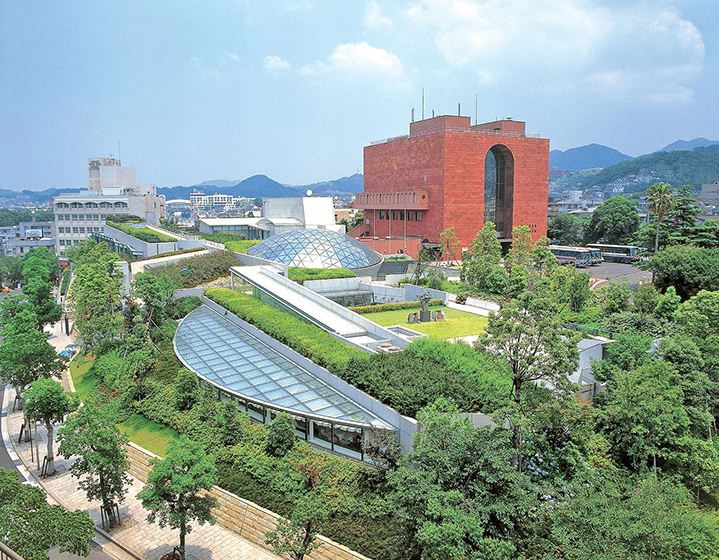
The museum consists of three floors with three completely different display spaces. On the first floor, as soon as you step in you will immediately see a water pond, almost any structure that talks about a Japanese atomic bomb has the presence of water, you must know how the victims of the atomic bombing need water to soothe the burns on their body. That is the reason why we always see the image of water in these structures.

And when it gets dark, the first floor will be light up to commemorate the dead of the bombing. The lighting time is until 6:30pm every day but the period from May to August will last until 8pm.
The second floor of the museum displays mementos and photos of victims who died in the bombing, all of them collected from their families, friends and even the final words of them before they died.

The third floor is also the main floor of the museum. If you want to know how catastrophic the atomic bomb is and how it affects the Japanese people then head to the peace information corner of the third floor.

Here, the sounds and images of the survivors’s narratives and the activities of those involved in the treatment of the survivors will help you understand all that. In this peace information corner you can also write peace messages in words or drawings by simple operation on the computer for Japanese people and they will be kept for 10 years. In addition, there are also the Nagasaki Atomic Documentary Gallery and the Nagasaki National Peace Memorial Hall for the Atomic Bomb Victims.
Visiting the museum you will see how strong the Japanese people and Japan was when overcoming these losses and developing the country as we’re seeing today. However, you should note that depending on the time of year, the opening hours of the museum will vary.
Address: 7-8 Hiranomachi, Nagasaki, 852-8117, Japan
Opened: 2002
Hours: 8:30AM–5:30PM
Tojin Yashiki
Tojin Yashiki Relic is the compound that in the past was used to build the residence for the Tang merchants of China. In 1635, Nagasaki opened trade with China and in order to limit the residence of these merchants and their illegal trade, the Nagasaki government built this residence.

Over time, the large of the compound is enough to accommodate for 2000 people has disappeared but only the Chinese worshiping architectures here such as Tenko-do Shrine/Temple, Kannon-do Shrine (Guan Yin Hall), Dojin-do Shrine (the Chinese God of the Earth Fukutoku).

Address: 6 Kagomachi, Nagasaki, 850-0905, Japan
Meganebashi Bridge
Meganebashi Bridge crossing Nakashima River which flowing in Nagasaki Prefecture is one of three most famous bridges in Japan along with Nihon-bashi Bridge in Tokyo and Kintaikyo Bridge in Yamaguchi Prefecture. The Meganebashi’s uniqueness is the bridge made of stone with a 2-storey arch structure with a length of 22 meters.

On sunny days, Meganebashi’s shadow shines on the river surface to create an image like a pair of glasses, so the name Megane (glasses) was born for this reason. You can take a leisurely walk on the bridge or cross the river flowing across the bridge with stones placed here.

At the embankments near the bridge, there are about 20 heart-shaped stones associated with a legend that the more stone hearts are found, the more easily the wish of love will come true. This makes Meganebashi Bridge even more famous and attracts more visitors looking for these heart-shaped stones.

On the Nakashima River, in addition to Meganebashi Bridge, there are many other bridges with names such as Amigasa-bashi, the bridge that the Samurai cross to heading towards the red light district, the Uoichibashi bridge once was used when transporting fresh fish from the port of Nagasaki, etc… If you have time you should walk to these bridges you will see all of Nagasaki in different landscapes.
Address: Uonomachi, Nagasaki, 850-0874, Japan
Total length: 22 m
Opened: 1634
Body of water: Nakashima River
Bridge type: Arch bridge
Chinatown
The Chinatown in Nagasaki is one of the three largest Chinese towns in Japan after Yokohama and Kobe named Shinchi-machi. Here, the shops lining up close together in a cross shape with restaurants, food stalls, souvenir shops and handicrafts…

Coming here, you will be satisfied for enjoying the authentic Chinese cuisine, freely to shopping. Especially if you come here on Lunar New Year, you will be participating in the Nagasaki Lantern Festival, experiencing Chinese culture right in Japan. It will be a way for you to understand the cultural exchange between countries.
Hashima Island
Located off the coast of Nagasaki prefecture, the island of Hashima is also known as Gunkanjima meaning “Battleship Island” because its shape looks like a battleship which is a popular tourist attraction.

Battleship Island Cruise in Nagasaki
The Hashima attracts visitors not because it has beautiful scenery or interesting entertainment activities, but in fact it is an abandoned island without a people. Previously, Hashima was home to thousands of mining workers, a small city floating in the sea to mine coal. But in 1974, the ban on mountain climbing and the cessation of coal mining led to the emigration to land for all and over time plus the erosion of seawater, all that remained of the island is crumbling concrete ruins, buildings exposing its inner frames …

Although it is decided to be open to visitors, you will need a special permit from Nagasaki City Council as well as the guidance of professional Japanese guides to enter the island, otherwise you just only can take the boat to getting around to see the island.

Due to the construction works on the island are too old and weak, tourists visiting the island have to walk on a predetermined winding road around abandoned concrete buildings and climb to the top of the tower, called “Stairway to Hell” to be able to enjoy a panoramic view of the island’s wilting from above.

You may not know, but Hashima Island was the inspiration and was built as a shelter for the villains in the episode 007’s Skyfall (2012). However, in reality when the film crew came to the island to measure and chosen because this place is too old and dangerous for the crew. Because of that, a rather similar version of Hashima was reconstructed instead of being shot directly on the island.

However, after dozens of years of being abandoned, in July 2015, Hashima was recognized by UNESCO as a world heritage site with the title “Sites of Japan’s Meiji Industrial Revolution”. This prompted the Nagasaki government and Japan to work together to preserve and save Hashima from the heavy losses from unforeseen storms in Japan.
Twenty-Six Martyrs Museum and Monument
Nagasaki is considered the cradle of Catholicism in Japan and the city today is the symbol of the Japanese Catholic Church that survives persecutions. Typical of which is the true story of 26 cloisterers and christians who have died for Catholic that to this day this Museum of 26 Martyrs of Japan has been built in Nagasaki.
In December 1596, three Japanese Jesuits, six Spanish Franciscans, and 17 Japanese christians were arrested in the Kyoto and Osaka. After that, all had their left ears cut off, tied together, and were led to walk nearly 1,000 km from one city to another during January 1597 during the cold, winter weather to serve as an example for people should not be religious. By February 1597, they were tied to 26 crosses on the hill of Nishizaka near Nagasaki, tortured and stabbed to death.
In 1962, on the occasion of the 100th anniversary of the canonization of 26 martyrs, the Japanese Catholic Church built on the hill of Nishizaka, Nagasaki a Memorial, a chapel and a museum containing the relics for the religion of these 26 saints.
Through these works, it has been shown that Nagasaki is indeed the intersection of different cultures, the starting place for religions to enter Japan.
Address: 7-8 Nishizakamachi, Nagasaki, 850-0051, Japan
Established: June 10, 1962
Hours: 9AM–5PM
Suwa-jinja Shrine

Suwa-jinja is the name of a shrine built in 1614 and currently stands on a beautiful hill overlooking Nagasaki city.
To get to the shrine you need to walk along many stairs. The shrine is known for its ornate sculptures of animals like “lion dogs” called Komainu and underwater species called Kappa Komainu.

Address: 18-15 Kaminishiyamamachi, Nagasaki, 850-0006, Japan
Strolling and learning history in Dejima
Dejima is the name of an artificial island in the port of Nagasaki and is also an important historical site in this region of Japan. The island dates back to 1641 when any foreign national in Japan had to come and live on the island and it became the headquarters of Dutch trading companies.
Today, you’ll find old houses as well as miniature replicas of what it looked like and this place is now an open-air museum called the Dejima Museum.

Address: 6-1 Dejimamachi, Nagasaki, 850-0862, Japan
Date formed: 1634
Boat riding to Iojima Island
If you are looking for an enjoyable experience on the beaches, you should depart from Nagasaki port to Iojima island on a boat. Boat ride takes about 15 minutes and then you can visit the island to enjoy white sand and blue sea.
You will also find hot springs here, so it’s a great place to relax outside of Nagasaki city.
Nagasaki travel guide: Shopping
Shopping in Japan is full of delicate pleasure – even whenn you watch the salesperson packing for you also is full of enthusiasm. If you want to shopping in Nagasaki, go straight to Hamamachi Shopping Arcade (Address: 6-2 Hamamachi, Nagasaki, 850-0853, Japan), this is Nagasaki’s largest shopping street. You will find countless shops and restaurants, which is also a convenient downtown area. This place also has a roof if the weather does not favor for you.

Nagasaki travel blog: What to eat?
Food is a reason for Nagasaki to be one of the attractive tourist destinations when traveling to Japan because the cuisine here is a combination of Portugal, China and Japan which making Nagasaki an strange and attractive unique culinary culture.
Champon
This is a noodle dish with broth is stewed from pork bones, chicken and served with meat, seafood, a variety of vegetables stacked on top. This dish is designed by chefs for low-income people to eat full but nutritious. So it is classified as a delicious and cheap food in the Chinatown.
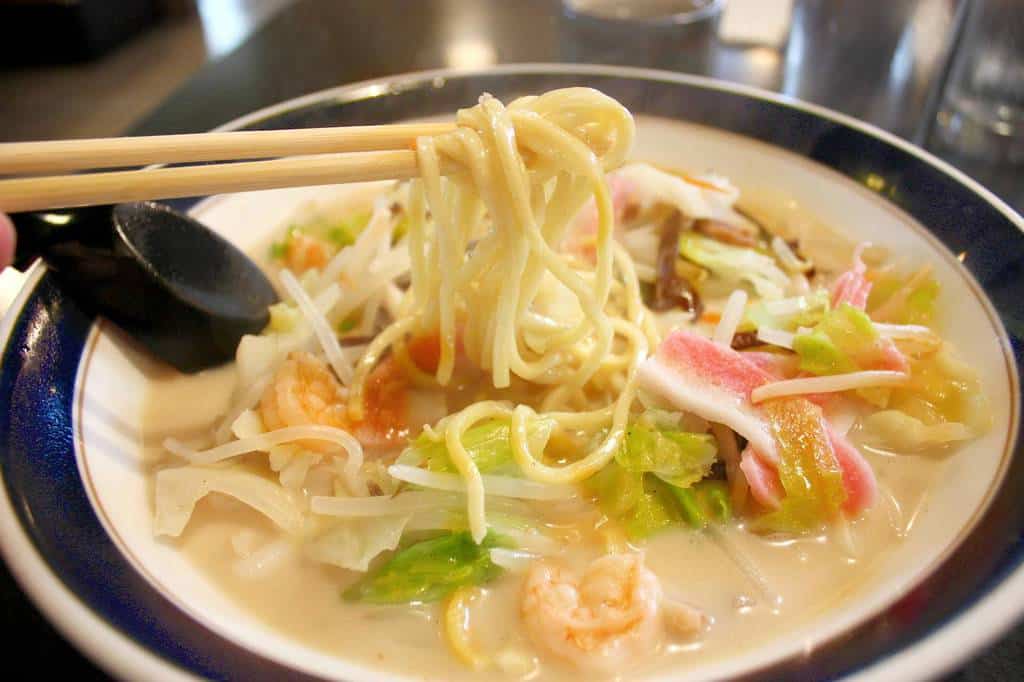
Nagasaki beef
Referring to this type of beef, most people in Japan probably know it because it is quite famous. The cow raised in Nagasaki is Wagyu, the cows are usually cared for in mild climatic conditions, giving the cows a balanced amount of fat to ensure taste when enjoyed.

Shippoku
Famous for its rich combination of Portuguese, Chinese and Japanese cuisine, to experience this combination for yourself you must try the Shippoku cuisine in Nagasaki. The dishes of these 3 countries will be placed on a round table for diners to enjoy to recognize the dishes of each place. The Shippoku dish dates back to the Edo period and is preserved to this day.
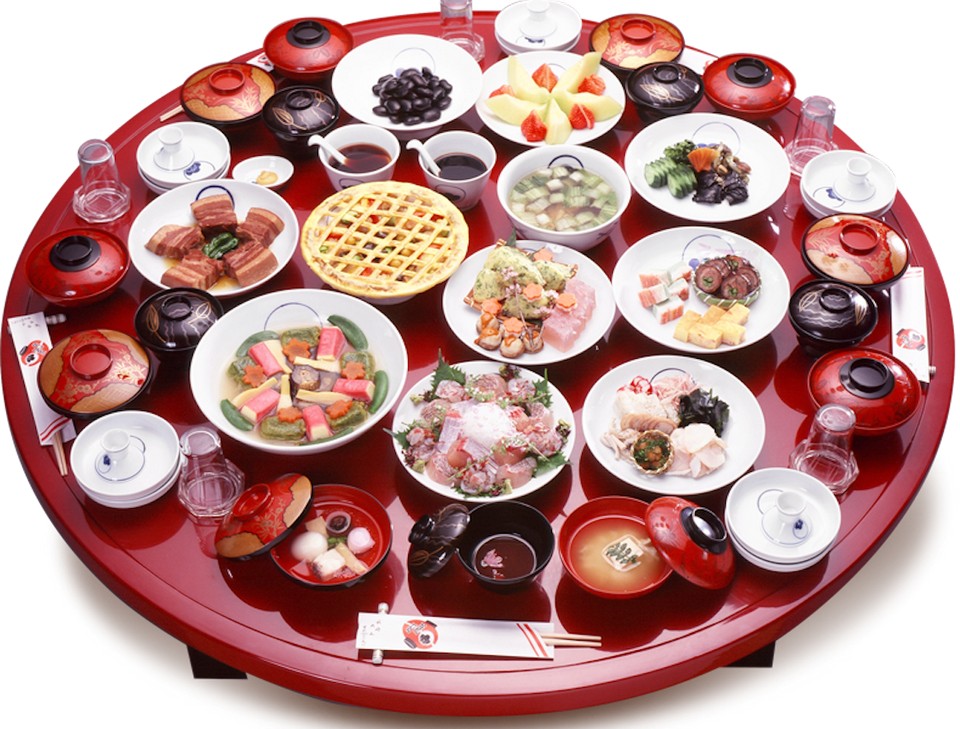
Castella
One of the best dishes of Nagasaki that you must try is Castella, a thick cake of Portuguese origin that is very strange when served with hot tea. The batter is poured into large square or rectangular molds, baked in an oven and cut into long rectangular shapes.

Leng keng Ice-cream
Ice cream “Jingle” is shaped like a rose and sold in street vendors.

Nagasaki tourist guide: Where to stay?
Below we recommend more best cheap, budget, mid-range and upscale hotels with good ratings and reviews you can refer to.
- Garden Terrace Nagasaki Hotel & Resort, a top rated 4-star hotel with room rates from $440/night (Check rates on Agoda.com or Booking.com).
- Hotel Forza Nagasaki, a top rated 4-star hotel with room rates from $82/night (Check rates on Agoda.com or Booking.com).
- JR Kyushu Hotel Nagasaki, a top rated 3-star hotel with room rates from $82/night (Check rates on Agoda.com or Booking.com).
- Hotel Monterey Nagasaki, a top rated 4-star hotel with room rates from $96/night (Check rates on Agoda.com or Booking.com).


Some best day tours, trips, activities and transfer services, tickets in, from and to Nagasaki you can refer to
- Nagasaki Shinkansen 1 Day Train Pass
- Nagasaki Private Historical Walking Tour
- Gunkanjima Island, Glover Garden, and Mt. Inasayama Day Tour in Nagasaki
- Battleship Island Cruise in Nagasaki
- Battleship Island Cruise Experience in Nagasaki
- Nagasaki Huis Ten Bosch Ticket
- Kujukushima Aquarium Ticket with Optional Pearl Pick Experience
- Kujukushima Sightseeing Cruise Ticket
- Nagasaki Atomic Bomb Museum Admission Ticket (Nagasaki)
- Nagasaki Huis Ten Bosch Ticket
- Glover Garden Admission Ticket in Nagasaki
- Huis Ten Bosch 1 Day Bus Tour From TENJIN
- Kyushu SunQ Pass
- JR Kyushu Fukuoka Wide Area Mobile Pass
- JR Pass for Whole Japan
Are you looking for more top things to do in Nagasaki: Tours, activities, attractions and other things? Let’s check it out here.
































![10 best airports in Asia in 2016 [RANKED] kuala-lumpur-international-airport-best airports in asia in 2016 by skytrax ratings](https://livingnomads.com/wp-content/uploads/2016/08/29/kuala-lumpur-international-airport-best-airports-in-asia-in-2016-by-skytrax-ratings-218x150.jpg)
















